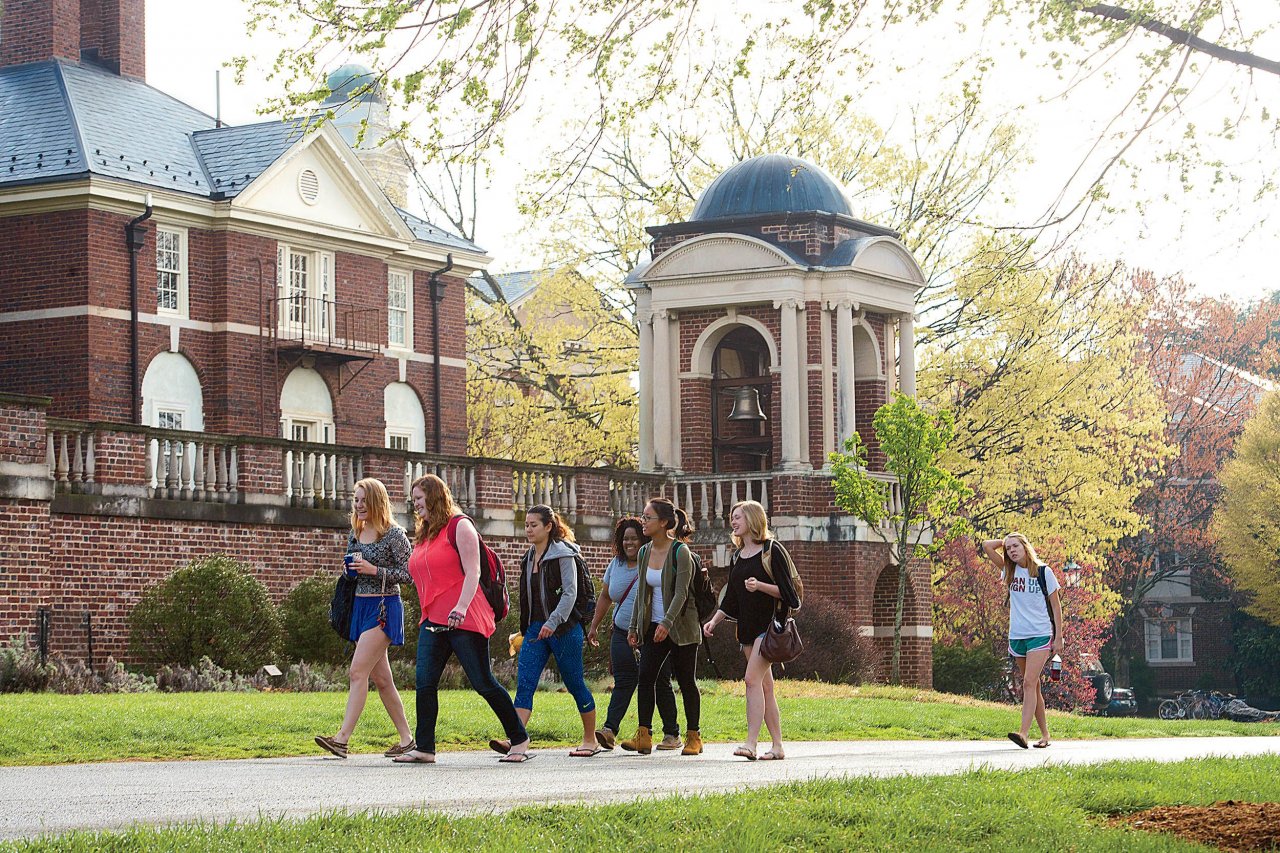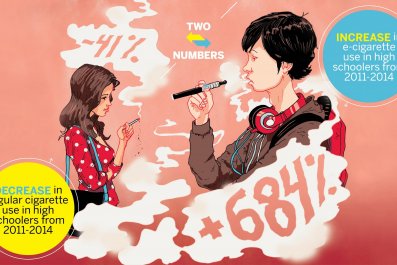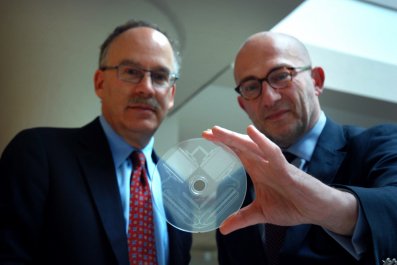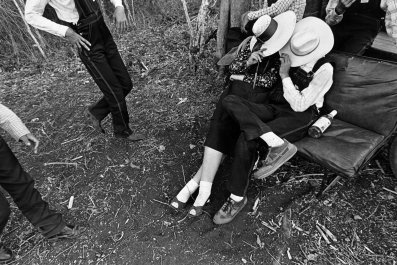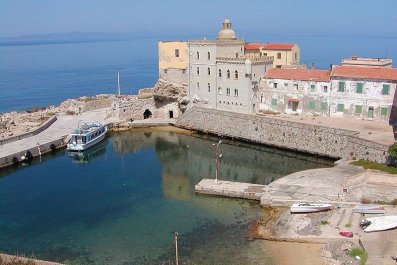I liked my college experience. A lot. At Dartmouth, where I went to school, the joke is that die-hard alumni bleed green—I once met an older alum who decorated his entire company's office in green, which is our school color as well as our mascot. But having spent a couple of weeks interviewing graduates of Sweet Briar College, a private women's liberal arts school in rural Virginia, I now understand that there is an even higher plane of collegiate adulation, and these women inhabit it.
"We were all sitting back in athletic clothing, probably not looking the best if a boy walked into the dining hall," says Tracy Stuart, who graduated in 1993. "No one had shaved their legs, and nobody cared either. Someone looked to me and said, 'This is the closest thing we'll find to utopia. This is a fantasy world. Where else can we live a life in such a beautiful location, learn from people who really care about us and eat food that's incredible?' We were known for having the best food—a dairy farm, homemade baked goods, really top-notch. I looked around and said, 'You know what? You're right. I don't think many places exist in the world like this today.'"
For generations, Sweet Briar was known as a finishing school for affluent Southern belles who rode horses and were looking for husbands. That reputation has faded, but when news broke in March that the tiny college would be closing its doors this summer, alumnae were outraged; those who knew a thing or two about women's colleges were surprised and saddened, and the rest of us asked ourselves, What's a Sweet Briar? To some, the school's death is yet another reminder that women's colleges are an increasingly unpopular undergraduate option, one that has been sliding into obscurity for decades. But at a time when American colleges and universities are teeming with rape, hazing and drinking scandals (104 schools are currently under federal investigation for their handling of sexual assault cases) and women continue to be underrepresented and underpaid in the workplace, single-sex schools may be the best thing that ever happened to women.
On March 3, faculty and staff at Sweet Briar received an email from interim President James F. Jones Jr. requesting their presence at a meeting in the school's chapel at noon. "Walking in, we wondered what they would tell us," says Nell Boeschenstein, 35, who teaches creative nonfiction. Was the school going coed? Was it changing faculty members' benefits or freezing their retirement contributions, as the college had done in 2009? Were they cutting a department? "I actually joked to a colleague when I said, 'Do you think they're here to fire all of us?' He laughed. And literally two minutes later we were all laid off."
At that meeting, Jones told his faculty the class of 2015 would be Sweet Briar's last graduating class, and in the coming months, the school would help current students transfer to other colleges and universities. "There was dead silence," Boeschenstein says. "People were weeping."
In a statement posted on the school's website, Jones cited numerous challenges: financial difficulties stemming from a "financially unsustainable" tuition discount rate, and declining interest among today's applicants in rural, liberal arts colleges as well as single-sex colleges. The number of women's colleges in the U.S. and Canada has plummeted in the last half-century, from 230 in 1960 to 47 last year, according to the Women's College Coalition. Some, like Wellesley and Barnard, have strong international brands, compete with top-ranked coed schools and have student bodies of around 2,400, but Sweet Briar is smaller and far more remote. As Jones told Inside Higher Ed, "We are 30 minutes from a Starbucks."
Between 2010 and 2014, undergraduate enrollment slid from 605 students to 561. Another issue is the tuition discount rate, which increased from 40.8 percent during the 2009-2010 school year to 57 percent in the 2013-2014 school year. (Full tuition, room and board cost $47,000.)
Sweet Briar's $85 million endowment may seem like a solid number for a small school, but $65 million of that is restricted, which means it was donated for specific purposes and isn't available, for example, to pay off bills or compensate faculty and staff. The college also has nearly $25 million in debt and $28 million in maintenance needs, including replacing the steam system that heats portions of the campus. Jones says it would take at least $200 million to keep Sweet Briar open. "As someone who's run schools for nearly two decades," he tells Newsweek, "the great mystery to me is how Sweet Briar managed to stay operating when every single vector—admissions, deferred maintenance, bonds—has been going south for a very, very long time."
Jones arrived at Sweet Briar last August after serving as president of Trinity College, in Hartford, Connecticut, for 10 years. "The general consensus is that they have been planning this for years, that they got a board in place that would vote for closure, and that Jones was brought in to do the dirty work," Boeschenstein says. "They swept everything under the rug—Southern style—for the sake of appearances."
Alumnae are dumbfounded and livid. "My husband and I established a scholarship at Sweet Briar in my mother's name. One of my classmates contributed money on behalf of her mother to the new library, and she's devastated," says Claire Griffith, who graduated in 1980. "They never pulled the fire alarm or called 911."
Jones, who has some very personal connections to Sweet Briar—his wife graduated in 1969, her sister graduated in 1982, and his great-niece is in the final graduating class this spring—insists that telling alumnae any earlier would have been disastrous. "If we had come forward with some kind of communications plan that would have announced that closure is imminent unless fill-in-the-blank, the bottom would have dropped out of the retention, and whatever progress we were making on enrolling classes would have collapsed," he says.
The school's silence and abrupt announcement, however, have mobilized graduates. "That there wasn't a more proactive effort to inform an incredibly engaged alumnae network was a near-fatal error," says Stephanie Smirnov, a public relations executive in New York City. "We're not only heartbroken but we're angry. The great irony is, this school trained us to be leaders and make a difference, and [it] now [has] that to deal with."
Within days of the news, alumnae launched the Saving Sweet Briar campaign, with the goal of raising $20 million. More than $10 million has been pledged so far, and $1 million has already been raised. Graduates also stood in the front row of the Today show audience, holding up signs and handing sweet briar roses to Al Roker, Matt Lauer and Savannah Guthrie. Margaret Atwood tweeted in support of #SavingSweetBriar, and Vivica Fox gave the movement a shoutout as well. But the campaign is still a long way from the $200 million Jones says the school needs, and celebrity shoutouts often galvanize only fleeting support. While the Commonwealth of Virginia filed a lawsuit to keep the college open and a judge ruled that the board could not use solicited funds to close the school, Sweet Briar's plans for closure haven't changed.
"Let's say they [Saving Sweet Briar] succeed and within a month there's a resolution and it's in their favor," says Lynn Rainville, director of Sweet Briar's Tusculum Institute, a historic preservation resource center. "What students are left? Which faculty are still there? How do you rebuild the reputation of a college and get new faculty to come? Who would come to a college that almost closed?" That's a lot of hurdles, and there's another: Who would choose a small, single-sex college?
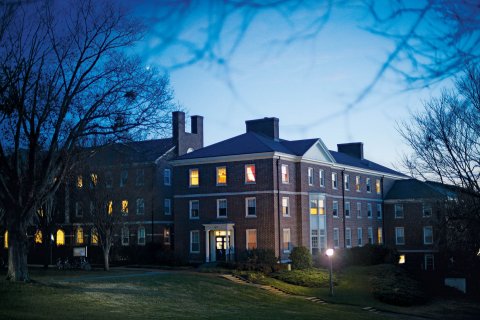
A Pretty History
Many alumnae say they fell in love with Sweet Briar the moment they first stepped on campus. The college sits on 3,250 acres in the foothills of the Blue Ridge Mountains, and boasts two lakes, six nature sanctuaries, a 130-acre riding center and 30 buildings that could hold their own on any Ivy League campus—21 of which are listed on the National Register of Historic Places. After passing through the school's majestic front gates, you follow a long, winding drive into a campus that's surrounded on both sides by fields, then trees. "By the time I got to the end of the driveway, I said to my mom, 'I'm going to go here!'" recalls Smirnov.
Sweet Briar was founded in 1901 as the legacy of Indiana Fletcher Williams, who left her 8,000-acre estate for the creation of a school for young women. But before Sweet Briar was a college, it was an antebellum Southern plantation. On the eve of the Civil War, 160 slaves worked for Williams's father. Today, a handful of original buildings and sites still stand on Sweet Briar's campus, including the plantation's "big house," built in the late 18th century, where college presidents have resided since the school's founding; a museum of artifacts from the college and plantation; a slave cabin dating back to 1840; and a slave cemetery with over 50 gravestones.
Sweet Briar ranked in the top 10 preppiest colleges in Lisa Birnbach's 1980 WASP-loving, bow tie-embracing cult classic The Official Preppy Handbook, which stated that it was the "origin of the stockings-under-pressed-jeans look. Very pretty girls, all of whom aspire to speak French so that they may spend junior year in Gay Paree." The school's colors, pink and green, boosted its preppy reputation. (They may scream Lilly Pulitzer, but they date back to the plantation, which was covered with pink sweet briar roses with green stems.)
Today, Sweet Briar has a decidedly more modern mission. "Something we like to say is, 'We did not get finished at Sweet Briar College. We were just getting started,'" says Briana Deane, a lawyer in Austin, Texas, who graduated in 2008.
Griffith credits her first job after college (at Merrill Lynch), her husband, her mentor and countless friends to Sweet Briar. "I was from rural Texas, and I was on financial aid, and nothing in my demographic said I would end up on Wall Street in New York City except for the fact that I had Sweet Briar and an incredible alumnae network behind me," she says.
One of the school's most notable young alumnae is Leah Busque, who graduated in 2001 and, seven years later, founded TaskRabbit, an online auction marketplace for outsourcing small, local jobs. In 2012, Fast Company named her one of the "100 Most Creative People in Business."
And she gives a lot of the credit for that to her alma mater. At Sweet Briar, Busque majored in math and computer science. "I never had the experience throughout college of being a minority student, because everyone was a woman," she says. "So I never thought about the fact that I might be a minority when I went into the workforce." After graduating, she worked as a software engineer at IBM, where she was one of the only women on her team. When she launched TaskRabbit, she was one of the few female CEOs in the tech world.
Busque also says Sweet Briar's close-knit community played a key role in her ability to grow TaskRabbit. "There was a special culture on campus," she says. "Neighbors helping neighbors, people pitching in, collaborating, supporting each other…. It's taken this last week [since Sweet Briar's announcement] to reflect on this, but the reason I was able to build the strong culture at TaskRabbit—we have 30,000 people across the country that are part of the community—is [that the company's culture stems] from my time at Sweet Briar. It isn't something I would have gotten at any other school."
Still, Busque understands just how hard it is to convince young high school applicants to give Sweet Briar a chance. "When they do come to visit Sweet Briar, they fall in love with it and want to attend, but with all the other schools and opportunities out there, it's a tough sell to get someone to consider a women's college."

Change or Die
Women's colleges in America were founded in the 19th century, when the vast majority of schools accepted only men. They educated their students in everything from art and literature to Latin and mathematics—but with the express purpose of preparing them to be better wives and mothers. By the early 20th century, women had won the right to vote, were moving to major cities and beginning to launch careers as secretaries, nurses, even doctors and lawyers. More American women enrolled in colleges, and by the post-World War II era, second wave feminism, gender equality and the sexual liberation movement collided, and more and more women abandoned their sisters at single-sex colleges in favor of coed schools.
If Sweet Briar does close, North America will be down to 46 women's colleges. Today, graduates of women's colleges make up just 2 percent of the college graduate population, yet they account for more than 20 percent of women in Congress and 33 percent of women on Fortune 1000 boards, according to "Why a Women's College?," a 2014 study. Nancy Pelosi, who attended Trinity College in Washington, became the first woman in Congress to serve as speaker of the House. The first female secretary of state, Madeleine Albright, went to Wellesley College, as did former Secretary of State Hillary Rodham Clinton, who recently announced she's running for president. Katharine Graham, the first female CEO of a Fortune 500 company (The Washington Post), graduated from Vassar College before it went coed. And Harvard University's first female president, Drew Faust, graduated from Bryn Mawr. Feminist icon Gloria Steinem, American cultural and anthropology icon Margaret Mead and Pulitzer Prize winner Jhumpa Lahiri? All graduates of women's colleges.
Today, alumnae of women's colleges report a higher level of satisfaction with their overall college experience than graduates of coed schools, and they are more likely to say they benefited from a safe campus environment, according to the 2012 "What Matters After College" study. Of those surveyed, 81 percent of women's college alumnae felt prepared for their first job, compared with 70 percent at liberal arts colleges and 65 percent at public universities. Graduates of women's colleges are almost twice as likely as public university alumnae to pursue graduate degrees.
These institutions also have more ethnically and racially diverse student bodies than coed schools, according to a 2014 study comparing the experiences of 262,722 female students at 49 women's colleges between 1971 and 2011 with the experiences of more than 4.4 million women at nearly 1,000 historically coed schools during these same years. While most women attending single-sex colleges in the 1970s came from well-off or affluent families, young women today come from families that fall into the lowest income brackets in the study.
With all of this good coming out of women's colleges, why are they struggling to survive? "The issue that Sweet Briar exemplifies is not so much about a women's college per se but about a college that does only one thing, which is liberal arts education. Liberal arts for both single-sex and coed colleges today is a declining industry," says Patricia McGuire, president of Trinity Washington University. "You have to change or you will die."
When McGuire became Trinity's president in 1989, the school had been suffering a decline in admissions since the 1970s and full-time enrollment was down to just 300 students. But a few years prior, the school had launched the Weekend College program for adult working women in the D.C. area that included about 500 part-time students in evening and weekend classes. "It was controversial," McGuire says, "but we had to change, and we would not have made it otherwise."
Today, Trinity has 2,500 students across five academic schools, including 1,000 in the women's college. "Trinity went from being a majority white Catholic traditional institution to majority black and Hispanic with a big mix of religions and ages," says McGuire. Most students work, and many are young mothers. The school also added coed graduate programs with direct pipelines to local job opportunities. Men make up 5 percent of the student body, and most are adult working men.
"It's very provocative to change the race, social class and religion that some people think are the mission of the school," McGuire says. "There were many years when the alumnae of Trinity said, 'You changed the mission!' And I'd look at them and say, 'No, the mission is the same. The women who enjoy the mission are different today.'"

A Terrible, Honorable Thing
Questions continue to swirl over Sweet Briar's demise. What will happen to the college's endowment? What job opportunities await professors, administrators and staff in rural Virginia? What are the legal ramifications of closing Sweet Briar when Williams's will specifically states that her estate be used for the creation of a women's college?
Speculation has also surfaced about the school's financials. Saving Sweet Briar recently announced that its advisers reviewed the college's financial statements for the fiscal years 2010 through 2014 and determined that it faces "no imminent financial emergency." The alumnae group formally asked Jones and the current board to resign. "It is apparent that they have given up on the college, even though the college remains viable," Ashley L. Taylor Jr., the lead attorney for Saving Sweet Briar, told Newsweek. "Our clients have developed a full slate of board members who are ready and willing to step in to run the college," he added.
Over the past decade, Jones says, Sweet Briar has tried numerous ways to fend off its current fate. Twelve years ago, the school aimed to increase its student body from around 600 to 800. Using unrestricted money from the endowment and other funds, Sweet Briar built a new athletic and fitness center, environmentally friendly townhouses for rising seniors and a building for student life. "The numbers never got anywhere near 800," Jones says, who adds that 43 percent of the class that matriculated last fall received Pell Grants, federal aid for low-income students; 37 percent are first-generation college students, and about one-third are minority students. The implication is that the school's cushy past as a training ground for rich girls—and later, a beneficiary of their charitable gifts—is no more. "What the college is doing is the equivalent of the second GI Bill but without the federal government funding it," Jones says.
Sweet Briar also added a graduate program in education and an engineering program, and cut German and the engineering management degree. In 2009, it streamlined its administrative offices, temporarily froze retirement contributions and cut a handful of jobs, all in an effort to boost efficiency. In the mid-2000s, Sweet Briar changed its slogan to "Think Is for Girls," written in pink across its website and admissions and marketing materials. (According to a more current page on the school's website, the phrase is now listed under "Outdated Phrases: Please don't use these.")
The school conducted an alumnae survey to determine if it could raise between $10 million and $12 million a year "to underwrite the operating budget on our way to raising $200 [million] to $250 million in the endowment," Jones says. "The capacity is not there."
Jones says Sweet Briar considered merging with another school or being absorbed by a larger institution. When marketing surveys repeatedly came back with negative feedback, it ruled out going coed. Not only did the school's name, school colors and mascot (the Vixen) present challenges, but Jones says Sweet Briar couldn't afford to build residence halls for men or launch the athletic programs that would be needed.
"The board voted unanimously" to close the school, he says, "and all but three members of the board of directors are alumnae, so you can imagine how hard it was to sit here with a Sweet Briar diploma, look at these facts that are intractable and have to vote to close down the school that many of them have loved for years and years."
As Sweet Briar alumnae grapple with the fact that their beloved alma mater will soon cease to exist—that their daughters will never have the option to attend and that the reunion this spring will be the last one in history—one might argue that there has never been a more crucial time for single-sex education. While women earn nearly 60 percent of undergraduate degrees and 60 percent of master's degrees, they still lag behind men in leadership positions and representation. Women account for 14 percent of executive offices, 8 percent of top earners and less than 5 percent of Fortune 500 CEOs, according to a 2014 report from the Center for American Progress.
Among lawyers, women are 45 percent of associates but 25 percent of non-equity partners and 15 percent of equity partners. In medicine, women represent 34 percent of all doctors and surgeons but 16 percent of medical school deans. Four percent of senior venture capitalists are women. "We live in a post-lean-in world. There is still a lot of energy and concern and debate in gender and pay equality in the workplace," says Smirnov. "Now more than ever we should look at places where women can go pursue a top-notch education and have leadership opportunities that they won't have in larger coed universities."
Jones stands by the school's decision: "To allow the school to continue to function until the day we have to turn the lights out and lock the doors would have been unethical in the extreme," he says. "Nothing can save Sweet Briar because nothing can change the market shift or the demographics of who wants to come to Sweet Briar," he adds. "It was a terrible thing to do, but it was the honorable thing to do."
There are many people out there, women and men, who know the value of single-sex colleges as well as the importance of diversity in the U.S. education system. One of the latest newcomers to the higher ed landscape is the Minerva Schools at KGI, an online college that opened in the fall of 2014 where students take all of their classes in fancy Google hangouts, live in a different country each year and pay just $28,000 in tuition, room, board and fees. These days, innovation and change are critical to survival. As Smirnov says, "It's a lazy rationale to say we've hit the end of the all women's school era. You certainly have to reinvent it."



